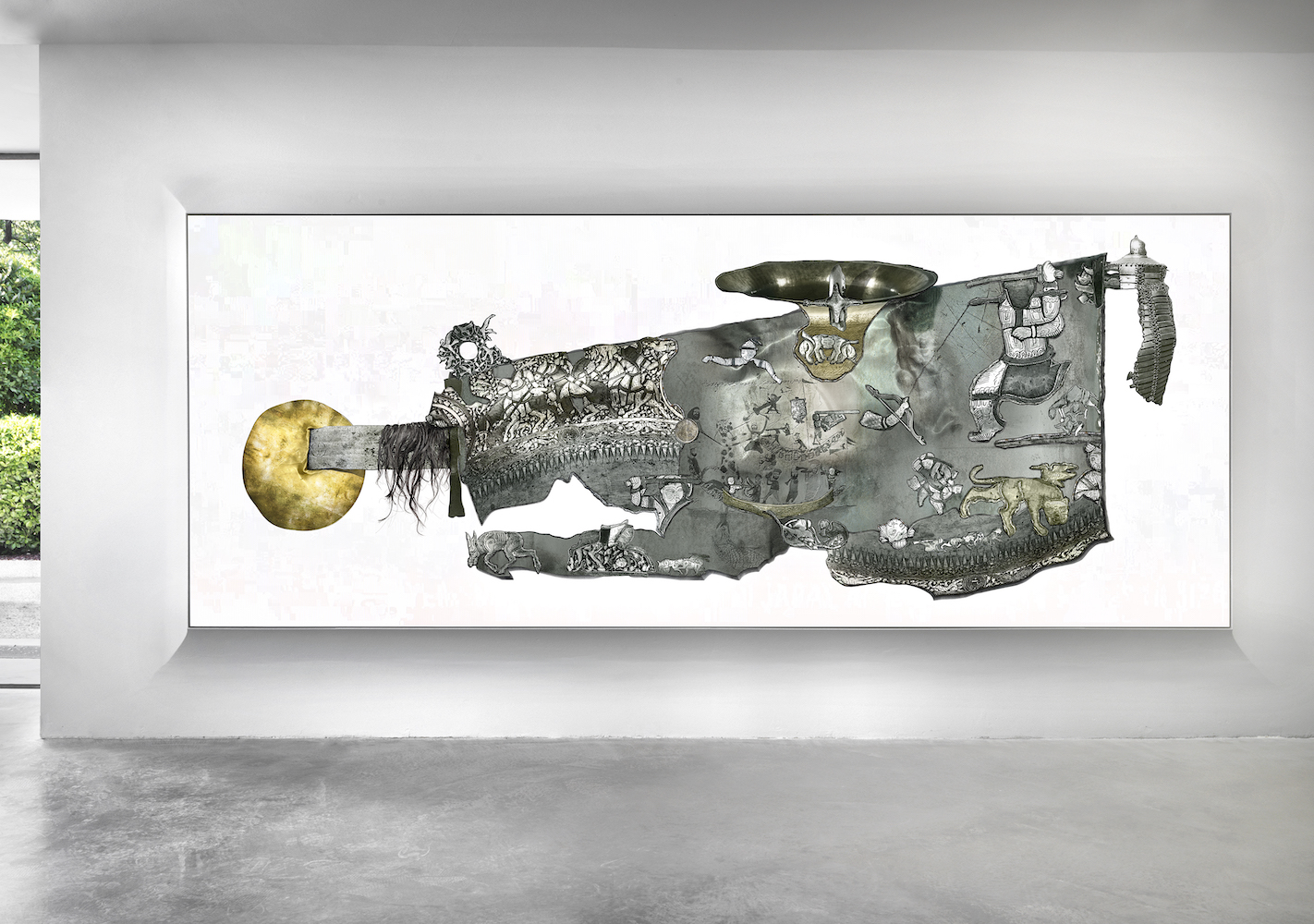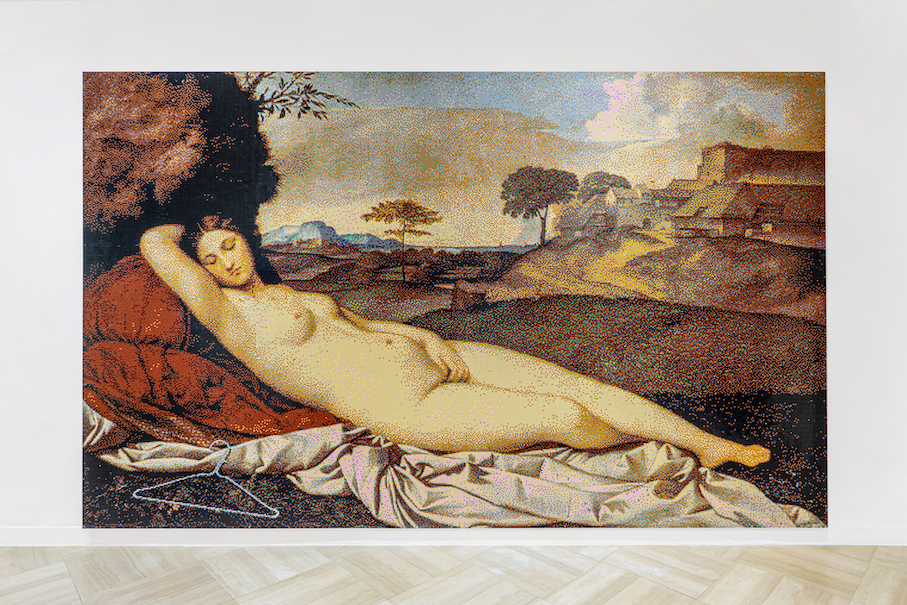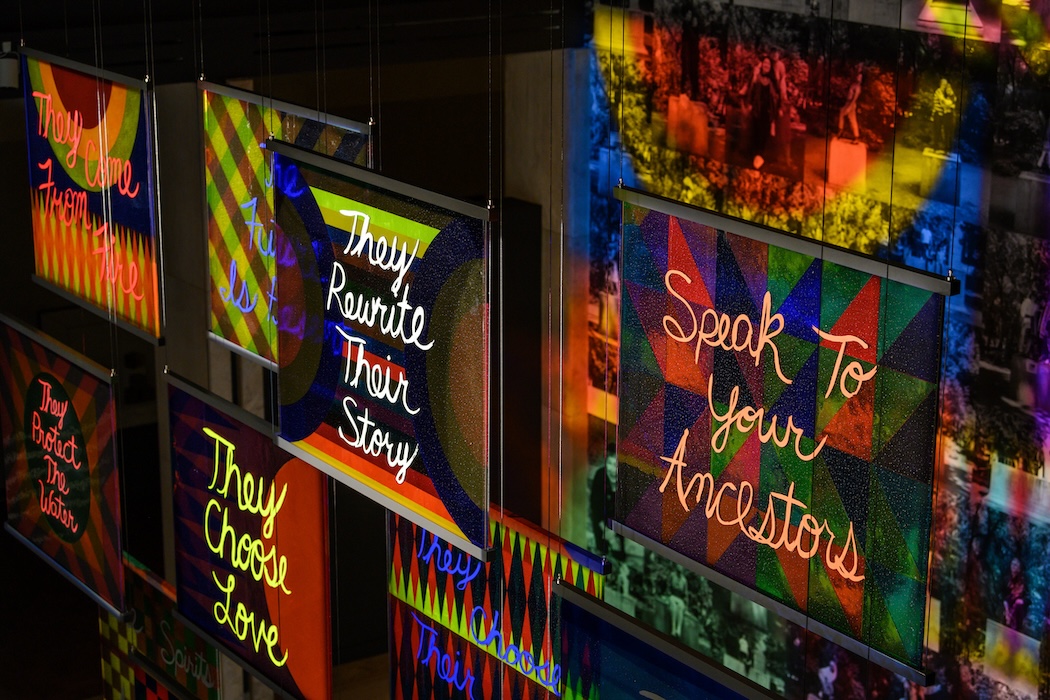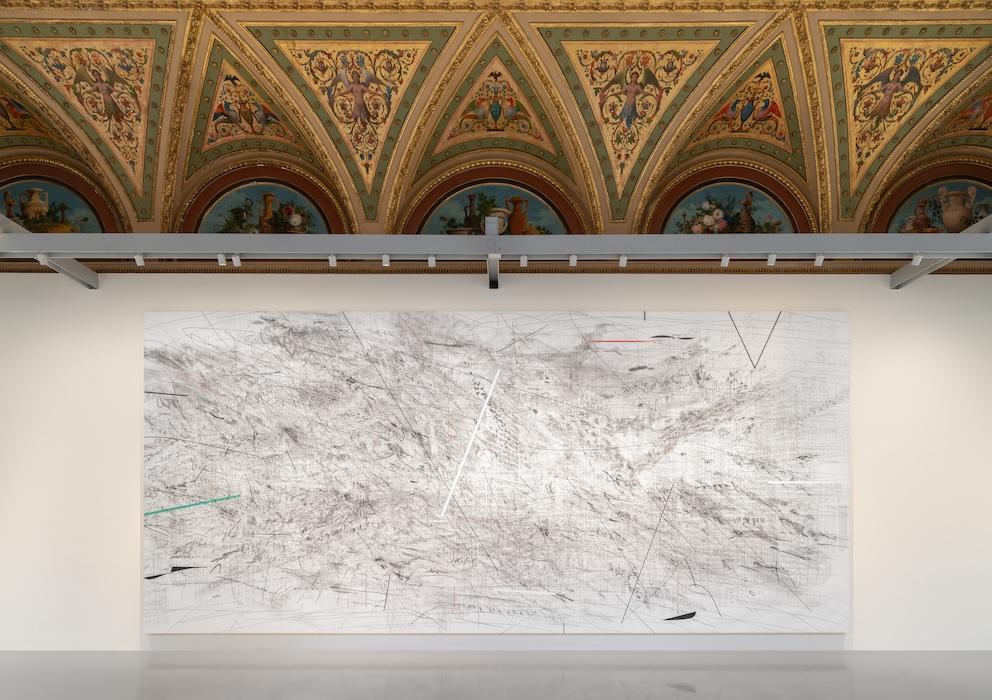Artist Ilit Azoulay represents Israel at the 59th International Art Exhibition – La Biennale di Venezia with a dynamic and thought-provoking project, titled “Queendom.” Curated by Dr. Shelley Harten, curator for Contemporary and Modern Art and History at the Jewish Museum, Berlin, the multidisciplinary exhibition is currently on view through November 27 in the Giardini della Biennale.
The “Queendom” palace shines a light of urgency on female and cultural empowerment. Azoulay drew inspiration from an almost forgotten archive of photographed medieval metal vessels from the Islamic world, assembled by the art historian David Storm Rice. The transformed pavilion consists of sweeping panoramic photomontages and architectural interventions, accompanied by an immersive soundscape produced in collaboration with light-language channeler Maisoun Karaman. Azoulay’s exhibition explores diversity, cultural appropriation, and the supreme power of art.
Dr. Harten, whose award-winning work and expertise lies in contemporary art, interconnected art histories, and cultural studies, sat down with the artist, energetic researcher, and investigator, to speak about the undiscovered, and forging new pathways of dialogue, and cross-cultural understanding.
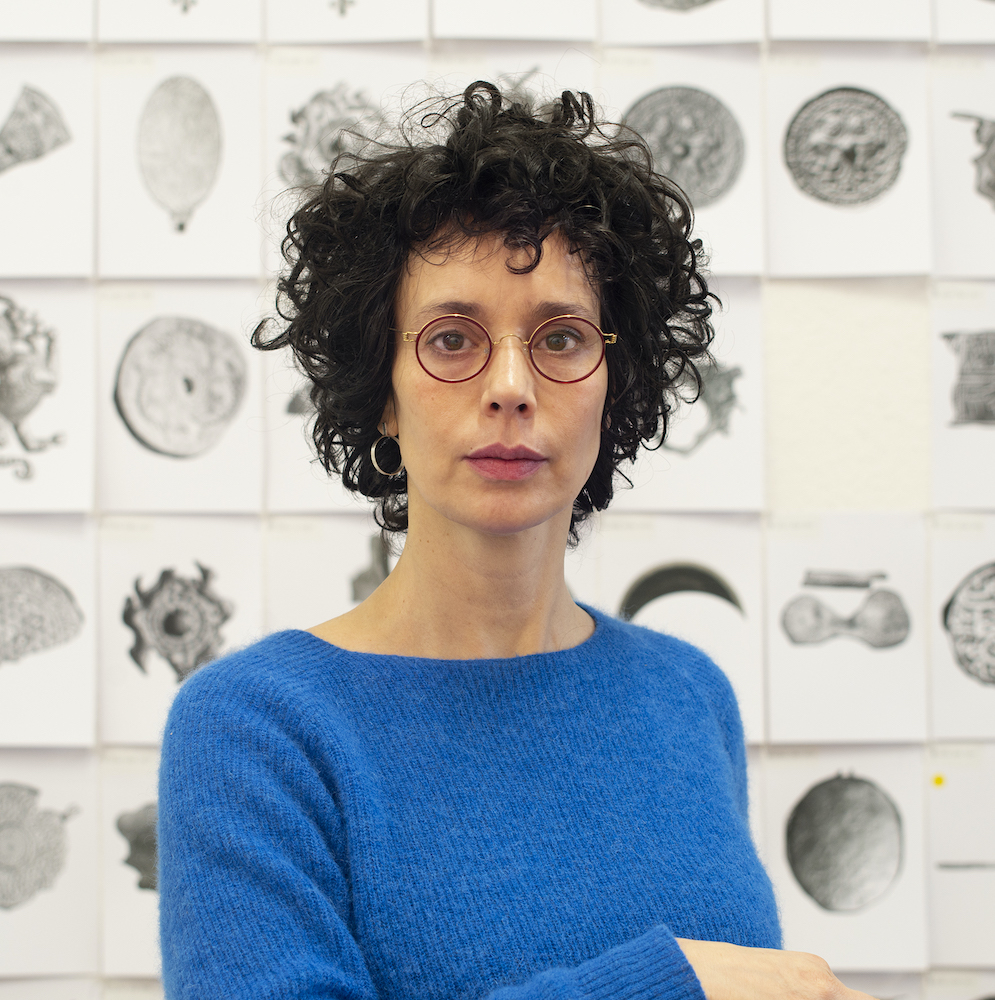
Portrait of Ilit Azoulay, Courtesy of the artist.
DR. SHELLEY HARTEN: To begin, how would you describe “Queendom”?
ILIT AZOULAY: It is an accumulative and collaborative space ruled by art. It is a proposal to rethink how we pass on information and a way to reframe the way we tell stories.
SH: Stories and histories are ways of creating and cementing power structures. Collective and individual knowledge is passed on from one generation to the next—it is hereditary. While some of it seems to be set in stone, much of it is fluid.
IA: I am interested in the way histories and stories are told and information is transmitted. I wondered what would happen if we were to change the hereditary line—the structures through which we pass knowledge on—and dispense of dichotomies and really listen and look at all of the data again. What occurs when we imagine a “Queendom” in which the information gains agency and demands our attention?
SH: From your description, “Queendom” is a network—a rhizomatic project that has many layers. There is the research base, which is the David Storm Rice archive, then the practical or methodological base, which is the way you approach the craft, and another more theoretical layer connected to Ursula K. Le Guin’s Carrier Bag of Fiction. In light of its complexity, what was your entrance point to the world of “Queendom”? How did your journey begin?
IA: I think it began with the ruins of other worlds—maybe it was the patriarchal world, maybe the Eurocentric perspective. Those systems of knowledge transfer do not seem to work anymore—their stories lost power.
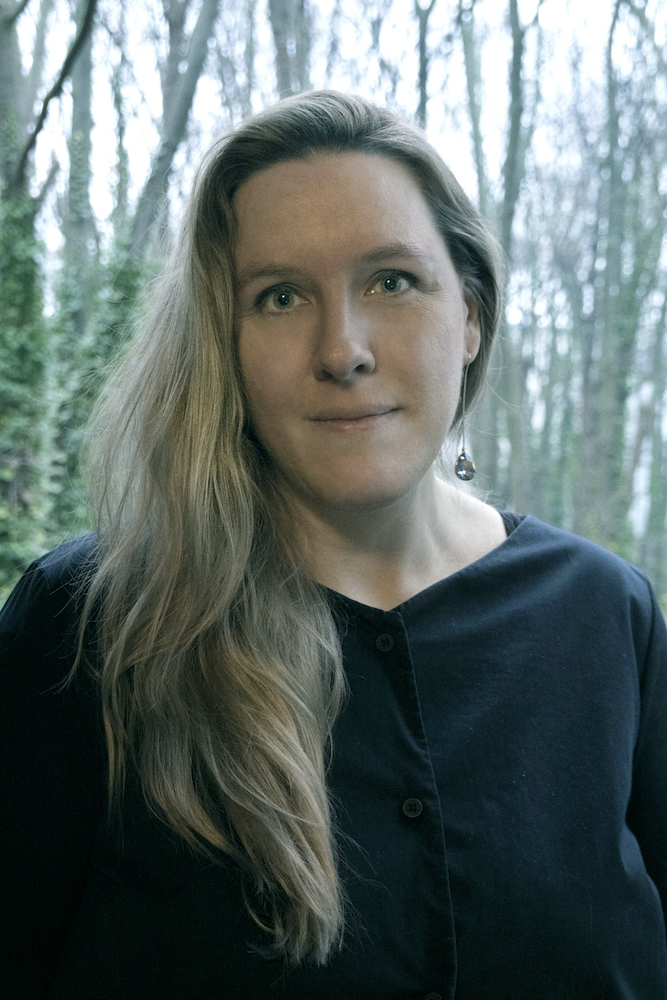
Portrait of Dr. Shelley Harten, photo by Yael Bartana.
SH: Yes, at least in the arts, those systems have crashed. The Biennale attests to it in many ways by focusing on minority voices while keeping some of those hegemonical structures, such as the national pavilions, alive. Before you started to work in the Biennale context, you quite literally encountered some of the detritus the “old worlds” left behind in the form of the David Storm Rice archive at the Museum for Islamic Art in Jerusalem. It became the research base of the project.
IA: Yes, it was early 2020 when Na’ama Brosh, curator emeritus for Islamic art at the Israel Museum, heard that the David Storm Rice archive was in danger of being disposed of. It is a huge collection of research photographs and documents of the Austro-Jewish British art historian and archeologist specializing in medieval inlaid metal vessels of Islamic art. He was born in the early 20th century and had an interesting trans-regional, though understudied, biography.
SH: Such a discovery seems to be a pivotal point in all your projects! In the beginning, you often pay close attention to something that has been overlooked or even put away with an intention of not making it visible. You lay bare the information contained in the objects without offering any didactic explanations of its meaning.
IA: Yes, I work in line with Ursula K. Le Guin’s theory that the first step towards human civilization was not a weapon, but a carrier bag that permitted gathering and sharing. It’s not the vertical tones of history, it’s the horizontal ones that I am interested in. I try, as a listener, not to get distracted by the big stories. It’s more about collecting the seeds and leaving room for more. Sometimes what is not said is also information, and what is set in darkness needs a bit of patience to become visible.
SH: How would you describe the David Storm Rice archive that laid the foundation of the project?
IA: There were hundreds of archival boxes containing black and white silver prints and around ten thousand negatives in different formats, mainly large camera formats. Ninety percent of them are macro photographs of vessels and objects, and the rest document other material that connects to those vessels.
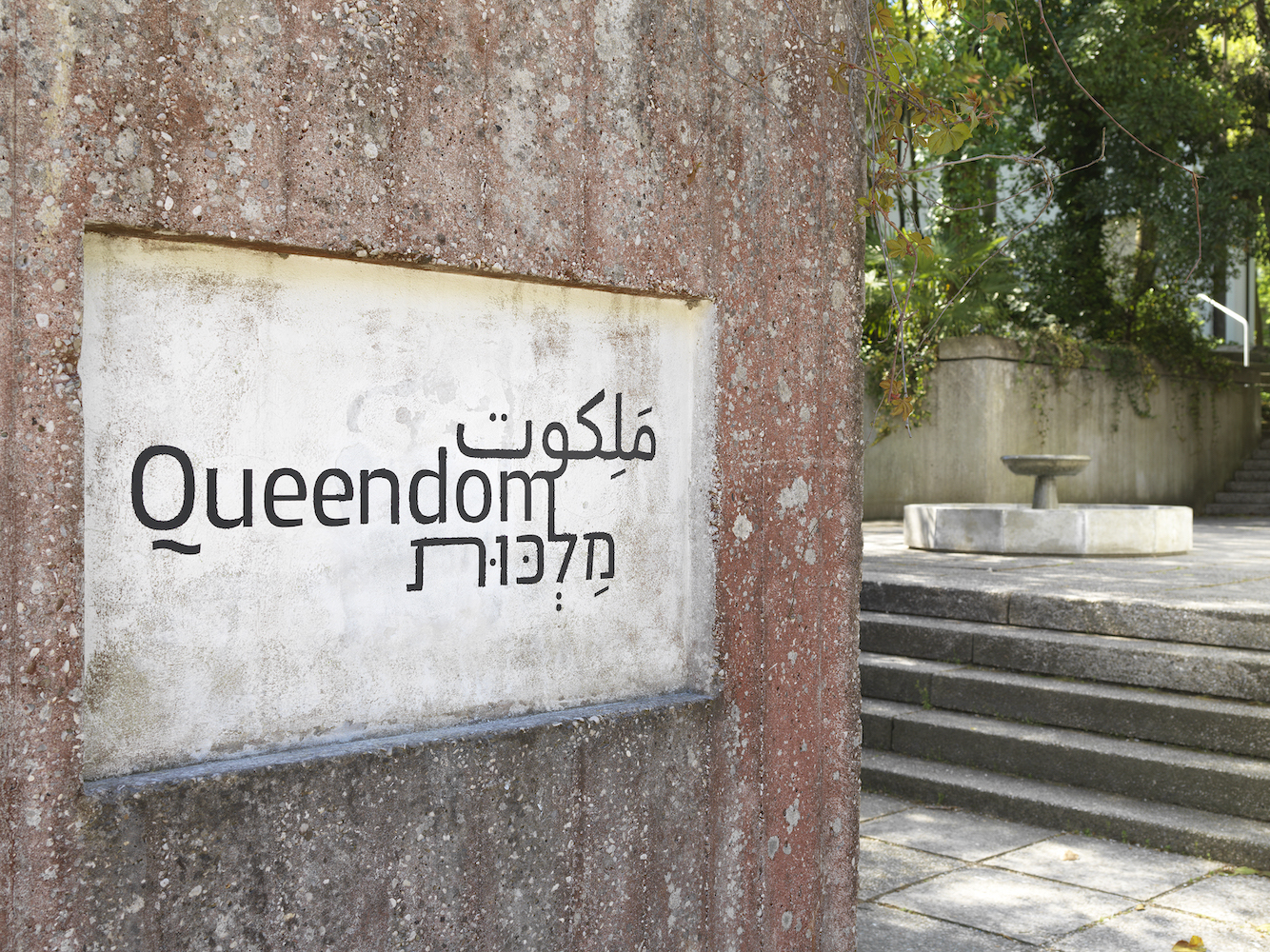
Installation view of Ilit Azoulay’s “Queendom,” photo by Jens Ziehe.
SH: Your description of this treasure trove shows that there are a lot of similarities between your work process and David Storm Rice’s. You both share a researcher’s imagination and the medium of photography to access information, but also the method of “scanning” objects piece by piece through macro-lens photography.
IA: I feel that I am very much in conversation with Rice, though not an expert in his field. What drove my first curiosity was not the vessels themselves, but it was more the way he looked at the vessels. I was amazed by the number of macro-photographs he took of each object. You can feel his body moving around it as he’s coming closer, even too close for what the lens allows. You could see that he was completely impassioned and possessed, as if his camera could record the stories coded in those vessels and he didn’t want to miss a word of it.
SH: He was possessed, and it seems he also wanted to be in possession of knowledge.
IA: There is something possessive in photography in general. I could sense a yearning to have more of the vessels than his retina allowed him to see. He seems to have worked intuitively— another approach we share. We both rely on testimonies, oral histories, contextual information and follow where they might lead us. Usually, I gather all this material before I even start to touch the camera and I create an archive that is based on this initial research phase. I go in with a macro lens only and I scan the objects through my camera. I don’t see myself as a photographer that strives for the decisive moment. I see my work as—some would say fiction— but I think it’s documentary work.
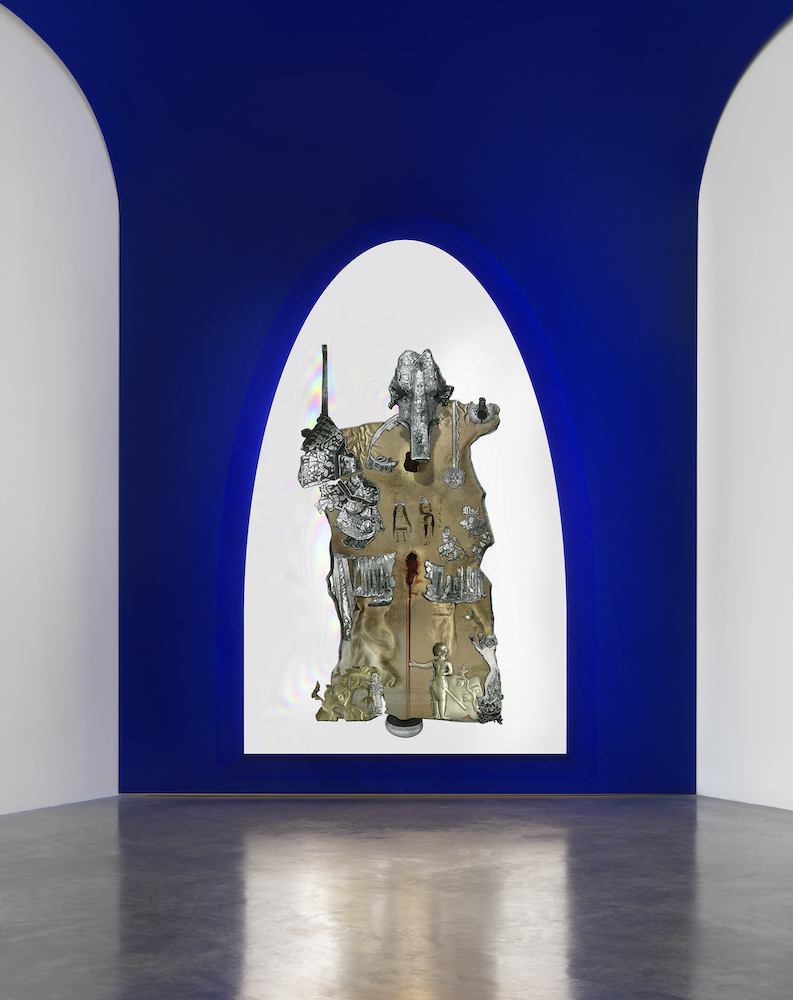
Installation view of Ilit Azoulay’s “Queendom,” photo by Jens Ziehe.
SH: Archives grow out of people’s cultural anticipations, memories, scenarios, and rules, so imagination is already a major participant in the archival process. I would describe your work as docu-imaginary or docu-fictional. Although archives are central to all your works, in “Queendom” the archival element seems to be on steroids: you take a meta-look at what archives stand for, whilst going deeper into detail and creating an archive out of an archive, finally culminating in a release of information that does not seem to adhere to any known systems of knowledge structure.
IA: I imagine this release came out of a crack in the wall, and that “Queendom” was so bright and powerful that only the crack was needed for it to appear out of the archive of David Storm Rice.
SH: Let’s discuss the next stage of your process, when all the initial material is laid out and the craftwork begins.
IA: It is all about zooming in and out of data. I go even more macro than David Storm Rice and I break, cut, crop, or reframe his original archival material. In the end traces of the documents remain, meaning the inventory number of the original photograph in the David Storm Rice archive, and the documentation of the vessel’s data, where it originated and where it is exhibited in the world today.
SH: You take a lot of care in extracting all the information. So how do you reassemble the resulting fragments?
IA: I repeat the steps of craft-making that were used to make the vessels in medieval times, after researching the way it was done. I choose and physically work on plates of brass, copper, and other metal surfaces. Then, with a macro lens, I again zoom in and photograph the metal surfaces inch by inch with my camera, combining these fragments of the metal plates to create a sort of digital canvas. Once I have those panel surfaces, I compose the “scrolls” by welding the puzzle pieces that I cropped out of the David Storm Rice archive onto the panels.
SH: The way you describe your work process feels like manual labor, even though it’s happening on the computer screen as a form of digital craftwork. The end products are large-scale paper works, rather than an installation of metal sheets as it might appear by looking at reproductions.
IA: Through the very detailed, patient work of collecting one seed and another seed and another seed, the picture is built from many tiny points of view. And yet, these are only parts of the bigger picture of “Queendom.” Because we used so many different angles and points of view, it’s not photography anymore; it becomes a cartography of information.
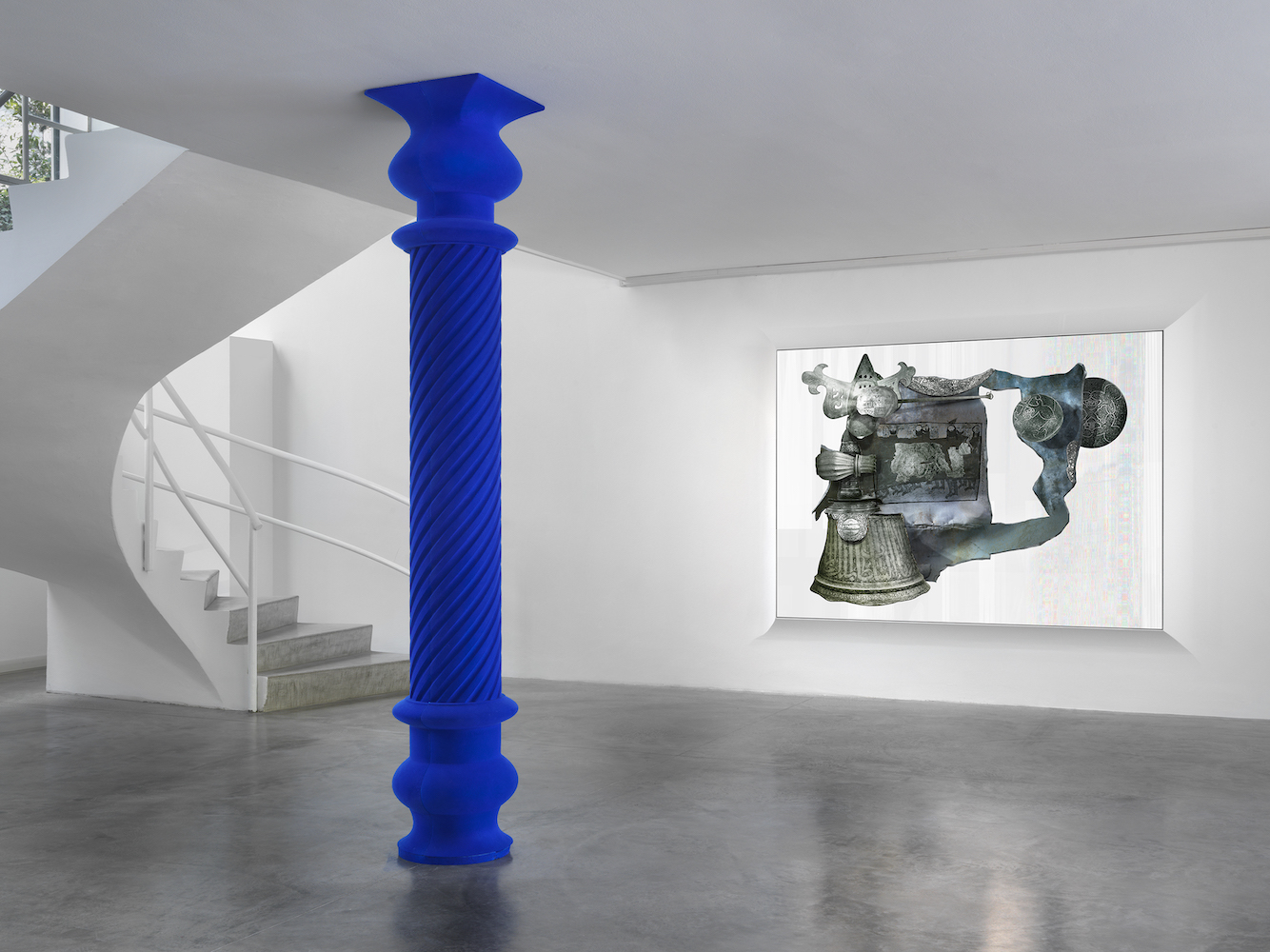
Installation view of Ilit Azoulay’s “Queendom,” photo by Jens Ziehe.
SH: A cartography that also traces the way the medieval inlaid metal vessels of Islamic art contained and disseminated information, which Rice was so interested in. Those vessels were produced by and for people of economic and political power, celebrating and commemorating victories, weddings, hunting scenes, folklore…
IA: …but mainly from a male perspective…
SH: Yes, within a patriarchal system of power that still dominates our world today. The vessels were passed on through history and are now exhibited mainly in Western national museum collections, where their craftsmanship and beauty are appreciated and the information they contain is investigated and researched. All this knowledge has been gathered and distributed through certain power structures. Though now, through your work, it gains an alternative interpretation. Do you feel that the digital space allows for a new contextualization?
IA: I think it’s a multi-dimensional space of all possibilities. By placing different elements in juxtaposition on the panels, it’s an alternative way of writing code. The writings of Ursula K. Le Guin have been very inspirational to me, as she redefines structures that we deem as set. She, for example, envisions gender to be cyclical and fluid. It is very liberating. In my work, I attempt to create an open space to let the “Queendom” show itself: the information that wants to rise will appear. Those entering the “Queendom: bring a whole set of new information with them to start new seeds of knowledge and conversation. How did you find “Queendom” resonating with your research?
SH: Each of us contributes to the “Queendom”’s network and I am curious to see how it will be discovered. I usually work on the fine and sometimes nonexistent line between art and history. I am interested in what can be described as a terra artis—a multifocal space of artistic imagination that can have very real consequences in our political, social, and cultural surroundings. As a cartography of knowledge, to me “Queendom”addresses the question of how we can structure information in a way that gives us access to unexpected, marginalized, uncategorized points of view, while raising awareness to all the filters we receive information through. We tend to frame things and pass them on from our perspectives. In the way that “Queendom” talks about appropriation, you ask the public to take responsibility for the way we see and teach the world today. At the same time, I noticed that there are parts on the panels that you have left blank. For me, they are allegories of forgotten or suppressed knowledge, similarly to the way that negatives play a role in photography—room for more.
IA: Definitely, I like to go back to this photo taken of Boulevard de Temps by Louis Daguerre. It shows the Boulevard empty in the middle of the day, which is not at all possible—it’s constantly packed with people. The negative, back then, needed a long exposure time, so the only people that made the step into the realm of the photograph was a man having his shoes shined and the person that shined his shoes on the bottom left of the photo. They stayed long enough for the chemical solution to write them into history. All the rest strolling in the Boulevard vanished. I like this analogy to talk about the fact that I’m looking for those missing voices, or those silver halides that were washed away with the chemical solution. At the same time, the “Queendom” is also only a very limited selection of transmitted data. It’s as if the panels arrived in a very certain moment through a crack in the wall to our world and revealed themselves in the pavilion as “Queendom.” Maybe if they revealed themselves in a different museum and a different country, in a different context—then it would all look and be perceived differently.
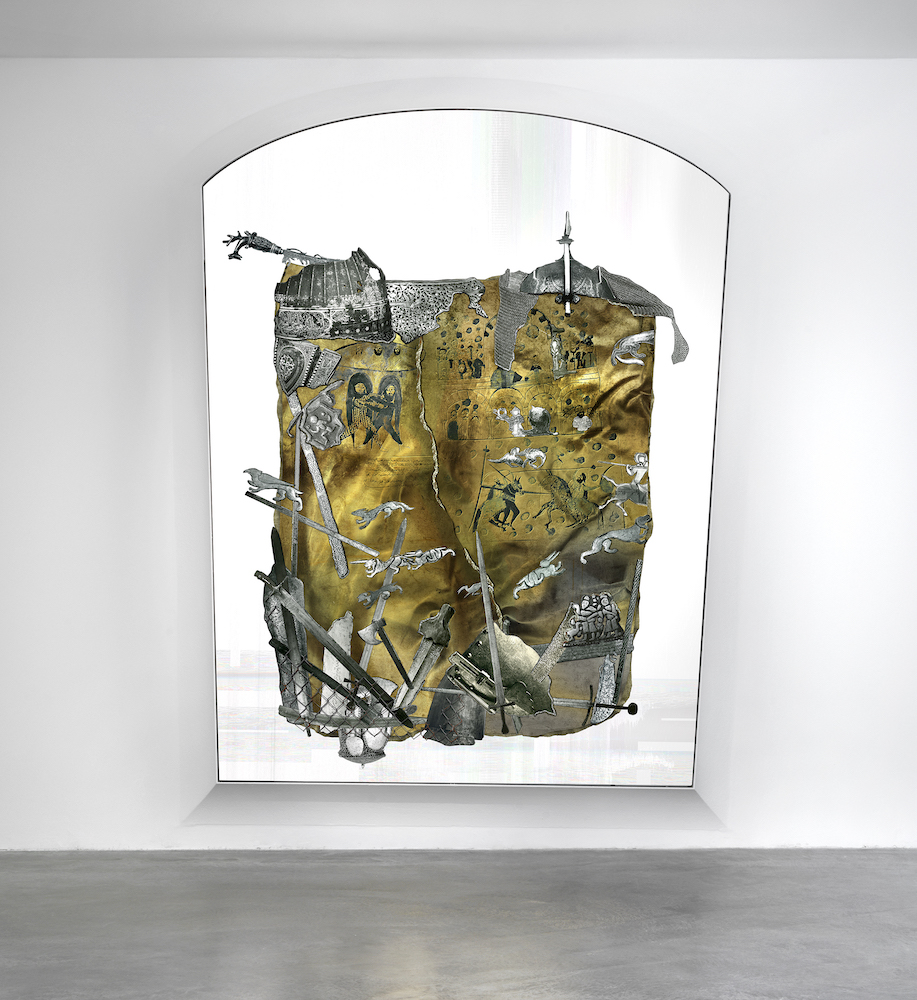
Installation view of Ilit Azoulay’s “Queendom,” photo by Jens Ziehe.
SH: The way that you have decided to portray the panels in the Israeli Pavilion within the Biennale context is a very specific one, which is countering the dominant narratives of that place that was, for a very long time, a male dominated, European, modernistic, national place of representation. Now, you are looking at Venice as a hub of cultural exchange and shared histories, not as a place of national competition.
IA: I’m questioning those structures. By turning the pavilion’s architectural outlook from a Western to an Eastern perspective, I’m literally opening a gateway to the East and adding a beautiful garden entrance to the rather forgotten backyard of the structure. The “Queendom” appears in the building with some of its elements, such as the blue ceiling and columns, finding manifestation in the pavilion’s reality.
SH: This transformation is felt throughout the pavilion. When visitors enter the exhibition space, they will hear the voice of Maisoun Karaman, the light language channeler you have collaborated with. Much like the panels, her transmissions seem cryptic and of a language that does not obey conventional structures.
IA: There is a shared coded element in my work and Maisoun’s transmissions. When we were working on the project and she was stepping into the “Queendom” sphere, the terra artis, she delivered her messages in a fluent stream, but I didn’t ask her to translate them for me. I made some of the works while listening to her transmissions, resulting in panels that took shape as the creatures from “Queendom,” rather than its cartographies. In any case, it feels to me as if the “Queendom” gains agency and wants to be seen and heard.
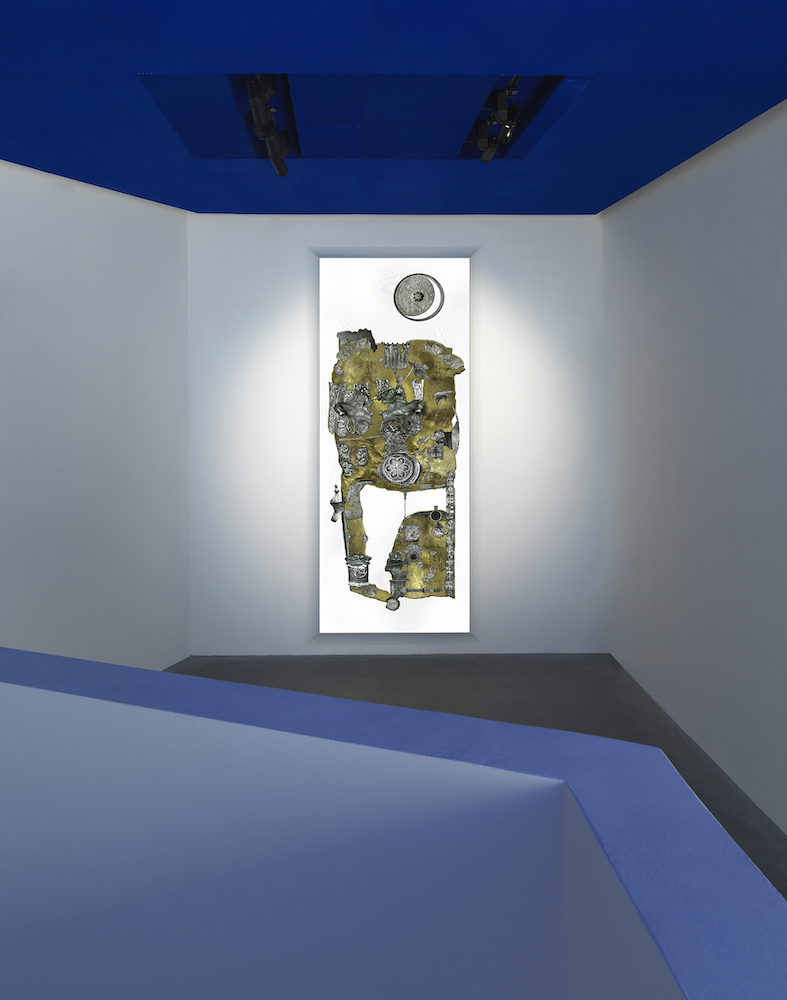
Installation view of Ilit Azoulay’s “Queendom,” photo by Jens Ziehe.
SH: “Queendom” is ruled by art, and by detaching the visual content from its context, you combine imaginary with fact-led information. What prevents the realm of “Queendom” to be a display of the Orientalist gaze, ameliorating Western stereotypes of an imagined East?
IA: I’m pointing to a certain gaze. When I’m talking about David Storm Rice as a white, Western man looking at art from the Middle East, it’s a snapshot of a specific time and place – a way of seeing the world. I hope that through the shared histories of the vessels, produced, traded, and displayed trans-regionally, through the interconnected paths of the David Storm Rice archive and my own as an Israeli artist of Moroccan origins and based in Berlin, it becomes apparent that information travels and we can be made aware of it, with all its complicated instrumentalizations and its beauty. At the same time, it is not a kingdom, but a queendom. A place to rethink, regroup, reimagine. The kingdom has crashed. Long live the Queendom!



